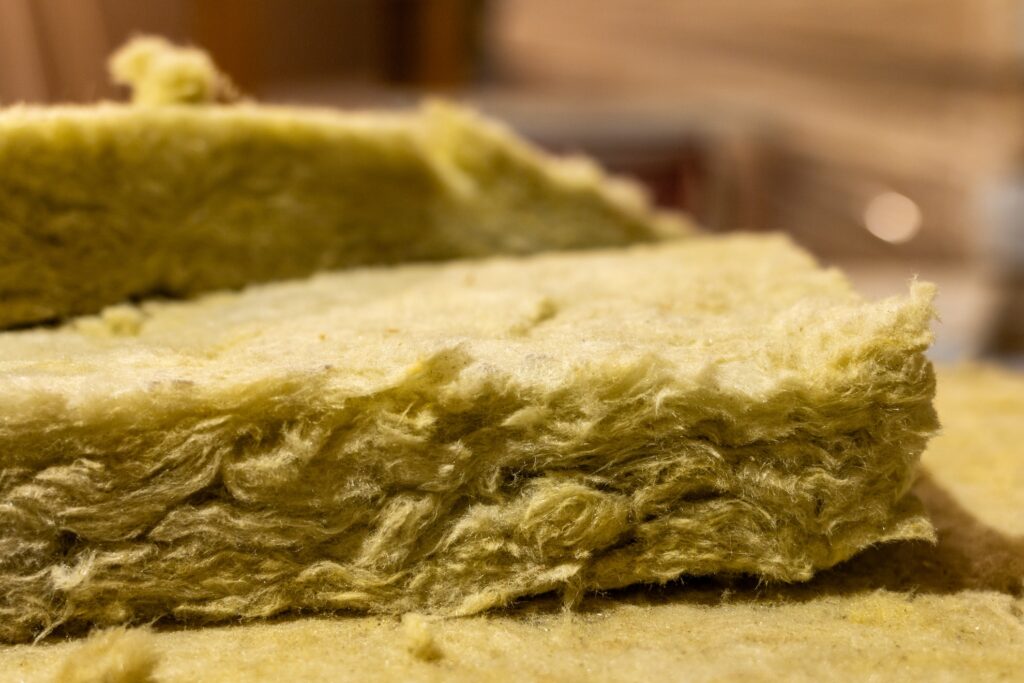
Fiberglass insulation has been around for decades. It’s the most commonly used type of insulation in American homes, mainly because it’s readily available and affordable. But fiberglass insulation has a lot of downsides and is rarely the best choice.
In this article, we explain why you shouldn’t use fiberglass for your home’s insulation upgrade and what type of insulation you should install instead.
What Is Fiberglass Insulation?
Fiberglass is a man-made fiber produced using small glass particles that are extruded into thin strands and generally used for insulation purposes. It can be blown into open cavities but often comes in large rolls or batts that are installed in walls, attics, and floors. The glass fibers trap pockets of air, and the trapped air slows down heat movement, keeping heat inside your home during the winter and blocking it out during the summer. For many homeowners, fiberglass is an entry-level choice, but there are other types of insulation that may offer better energy efficiency and comfort in the long run.
The Problem with Fiberglass Insulation
Despite its widespread application, fiberglass insulation has many drawbacks. In many cases, fiberglass insulation is dangerous and can pose a threat to your health and safety.
Installation Concerns
Fiberglass insulation is tricky to install, especially in batt form, because it comes pre-cut. If the batts are too small for the area you’re insulating, there will be gaps left around the edges, which can significantly reduce the insulation’s R-value. If they’re too big, you’ll have to shove the batts into place, which compresses the insulation and reduces its effectiveness.
Skin Irritation
Fiberglass insulation is also known as glass wool. It’s made from recycled glass and sand particles that are heated and spun to transform them into very thin fibers. The finished product has very small individual fibers that can embed in your skin if touched. This can result in serious skin irritation that can cause itching, redness, and rashes, especially if you have sensitive skin.
Respiratory Irritation & Breathing Problems
Inhaling fiberglass is dangerous and having this material in your home can put you at risk. Here’s how: When fiberglass particles are disturbed they can become airborne. Once airborne, the particles can be easily inhaled, which can cause a range of health concerns including eye, nose, and throat irritation. If you have an existing respiratory condition like asthma, inhaling fiberglass dust or insulation particles can make your symptoms worse.
Moisture & Mold Concerns
If you are going to install fiberglass insulation in your home, make sure it stays dry. Fiberglass can hold moisture, which puts it at risk. Moisture will cause fiberglass insulation to deteriorate over time and lose its effectiveness. Not only will this affect its integrity, but it also promotes mold growth.
Air Leakage
Fiberglass insulation is less dense than other types of insulation and does not create an airtight seal, which means air can travel freely through the insulation. This is called air leakage and it’s one of the most common sources of energy loss in a house. If proper steps are not taken to air seal the house before installing fiberglass insulation, it will not perform effectively.
The Best Alternative to Fiberglass: Cellulose Insulation
The good news is that fiberglass insulation is not the only affordable option for home insulation. Cellulose insulation is an excellent alternative that’s safer, more effective, and easily affordable, especially when you take advantage of insulation rebates and tax credits.
What Is Cellulose Insulation?
Cellulose insulation is an eco-friendly insulation material made primarily from recycled paper products, like old newspapers, that have been treated to resist fire, mold, and pests. It’s typically installed by blowing loose-fill cellulose into wall cavities, attics, and other hard-to-reach areas, where it settles to create a dense, effective barrier against heat and cold. Cellulose insulation has many benefits over fiberglass insulation. It poses fewer health hazards, performs better, and is more environmentally friendly. Plus, it’s an affordable option that will greatly improve your home’s comfort and energy efficiency.
Find the Best Insulation for Your Home
Want professional advice regarding the right type of insulation for your home that’s safe for you and your family? Call Neeeco today! We’re an energy efficiency expert that’s been installing insulation in homes throughout Massachusetts for years. Our team will evaluate your home’s existing insulation, talk to you about your goals and budget, and recommend the best insulation material for your home. We can also help you take advantage of rebates and incentives to reduce the cost of your insulation upgrade.
